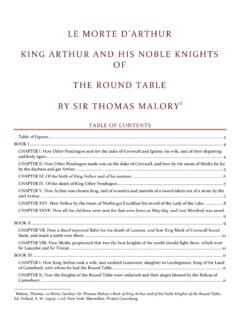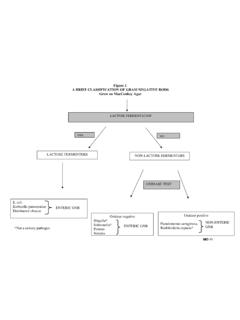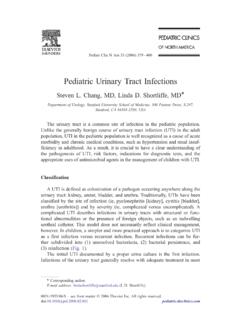Transcription of HOW TO WRITE AN UNKNOWN LAB REPORT IN …
1 HOW TO WRITE AN UNKNOWN LAB REPORT IN MICROBIOLOGYGENERALU nknown reports in microbiology are written in scientific format. Scientific writing is writtendifferently from other types of writing. The results of the exercise or experiment are what are beingshowcased, not the writing. The purpose of scientific writing is not to entertain, but to inform. Thewriting should be simple and easy to understand. There is a specific style that must be followedwhen writing scientific writing is typically written in the passive voice. The pronouns "I", "We" and "They" arenot typically For example, instead of writing "I used a TSA agar plate to isolate myunknown," it is customary to WRITE , "A trypticase soy agar (TSA) plate was used to isolate theunknown."It is also customary to WRITE in the past tense for most of the REPORT . This includes the introduction,the summary, the description of the materials and methods and the results. The present tense isreserved for the conclusions about the results.
2 See the examples given other general rules that should be followed are:Microbial nomenclature: The name of the bacterium should written and spelled correctly. The nameshould be italicized or underlined. Italicized is preferred. For example, Staphylococcus genus is capitalized but the species is not. After the full genus name is given in the paper, it canbe written as S. aureus, but still italicized. This is as long as there in no other genera in the paperthat starts with the same TO THE UNKNOWN LAB REPORT (Note: Other than the title page, the pages of the REPORT must be numbered)TITLE PAGET here should always be a title page and should include the following information:EXAMPLE OF TITLE PAGET itle should be centered and at the top or in the middle of the pageUNKNOWN LAB REPORT # 1 This information should be centered and at the bottom part of the title page: UNKNOWN LETTER (OR NUMBER)YOUR NAMEDATE (the due date)LAB INSTRUCTOR'S NAMECOURSE NAMESEMESTER / YEARSECTION NUMBERINTRODUCTIONThis section introduces the reader to the study and why the study was done.
3 This should only be afew sentences : "There are many reasons for knowing the identity of microorganisms. Thereasons range from the knowing the causative agent of a disease in a patient, so as to know how itcan be treated, to knowing the correct microorganism to be used for making certain foods orantibiotics. This study was done by applying all of the methods that have been learned so far in themicrobiology laboratory class for the identification of an UNKNOWN bacterium."MATERIALS AND METHODSThis is where the details of the study are listed. Where did the specimen come from, and whatmethods were used to identify it? Be specific, but do not re WRITE the lab manual. One way is tomention the names of the materials used and reference the lab manual for the procedure or methodand then continue to elaborate when necessary. See example 1: "An UNKNOWN labeled as letter G was given out by the lab instructor. Themethods that have been learned thus far for identifying bacteria have been applied to this were followed as stated in the course laboratory manual by De Mers (1), unlessotherwise first procedure that needed to be done was to streak the UNKNOWN out on a Trypticase Soy Agarplate, using the T streak method described in the lab This needed to be done in order to testthe purity of the UNKNOWN .
4 After the plates were incubated and grown, the morphology wasobserved and recorded and a gram stain was performed. Quality control bacteria were gram stainedalong with the UNKNOWN to make sure that the gram stain reaction was done correctly . Afterdetermining the gram reaction, specific biochemical tests were performed. The biochemical testswere chosen from the UNKNOWN identification tables that were in the lab manual. Since UNKNOWN Gwas determined to be a gram negative rod, an oxidase test was performed and the organism wasinoculated into a BCP lactose tube. Note all of these tests were performed by the methods listed inthe lab manual by De Mers (1). Table 1 lists the test, purpose, reagents and results. All of thefollowing tests were performed on this UNKNOWN :1. Oxidase test2. BCP Lactose3. Indole4. H2S5. Citrate6. Motility7. Methyl Red8. Urea"Another way is to WRITE out the methods in detail in either a paragraph form or listed. This way isnot necessary for this type of paper, since this is lab REPORT for the identification of an unknownbacterium and the methods are explained in detail in the lab manual.
5 If there is a procedure that theinstructor added or made changes to, or the student used another procedure not in the course labmanual, then it should be written out and referenced. See some of the examples of papersidentifying an UNKNOWN from the web sited is where the results are summarized. The method results should be in a table format (seeexamples below). This is also where the flow chart showing how you arrived at the answer is short paragraph explaining how the results are presented can be : UNKNOWN G had the following morphology on a TSA plate: medium sized opaquecream colored colony. After determining that it was a gram negative rod, an oxidase test wasperformed and it was inoculated into a BCP lactose tube and onto a TSA slant. Table I lists all of thebiochemical tests, their purpose and results. The results are also shown in a flow chart : Table 1: Biochemical Test ResultsTESTPURPOSEREAGENTSOBSERVATIONSRE SULTSGram stainTo determine the Gramreaction of thebacteriumCrystal violet,Iodine, Alcohol,SafraninPink rodsGramnegativerodsOxidase testTo determine thepresence ofcytochrome cOxidase paperPurple / blackcolor changePositiveoxidasetestBCP LactoseTo determine theability of a bacteriumto ferment a specificcarbohydrateNoneColor changefrom purple toyellowPositivelactosefermenterIndole TestTo determine theability of an organismto split indole fromtryptophaneKovac's added to1 ml of tryptonebrothRed Ring at topof brothPositiveindole type of table: Table 1.
6 Physiological and Biochemical ResultsTESTREAGENTS ORMEDIATEMPOBSERVATIONSRESULTSINTERPRETA TIONSC itrateCitrate slant(green)350 CColor changed fromgreen to bluePositiveOrganism is able toutilize citrate as acarbon sourceMethylRedMRVP350 CAfter addingmethyl red to oneml, color changedfrom light yellow toa darker yellowNegativeOrganism is not ableto produce largeamounts of acid fromglucose fermentationFLOWCHARTUNKNOWN GGram stainGram negative RodOxidase test (positive)PositiveNegativeCitrobacter freundiiProteus vulgarisEnterobacter aerogenesProteus mirabilisEscherichia coliSerratia marcescensKlebsiella oxytocaMorganella morganiiKlebsiella pneumoniaePseudomonas aeruginosaPseudomonas aureofaciensIndole test ( Positive)PositiveNegativeEscherichia coliCitrobacter freundiiKlebsiella oxytocaEnterobacter aerogenesKlebsiella pneumoniaeCitrate Test ( negative )PositiveNegativeKlebsiella oxytocaEscherichia coliMotility Test (positive)Escherichia coliMethyl Red Test (positive)Escherichia coliUnknown B - Escherichia coliDISCUSSION / CONCLUSIONThis section interprets the meaning of the results.
7 The following questions should be answered here:How did the test result lead to identification? Was it the correct identification? If not, why not. Whatproblems were encountered? This is also where the background information on the organism(environment/pathogenicity) that was identified is of a discussion: After several differential tests, it was concluded that UNKNOWN G wasEscherichia coli. After performing the gram stain to determine that the UNKNOWN was a gram negative rod,the organism was grown on a TSA slant for use in inoculating the rest of the biochemical tests. All of thebiochemical tests worked well except for the indole test. It gave a false negative result at first. This wasdetermined since it was inconsistent with the rest of the result. The TA suggested that the test be repeated andit was repeated. The repeated test gave a positive result, consistent with the other data. Therefore it wasconcluded that the UNKNOWN was Escherichia coli. THIS CAN BE ELABORATED MORE FOR coli is in the Enterobacteriaceae family.
8 It is typically found in the human intestines, as well asother animals. It can cause disease in the right host. THE REST OF THIS INFORMATION SHOULD BERESEARCHED FROM THE TEXTBOOK, INTERNET OR OTHER MICROBIOLOGY :Note: the minimum number of references is three, the lab manual, textbook and atlas. More can beused. Correct reference format must be used. References should be numbered and the numberadded to the REPORT when necessary. See example 1 under materials and methods. Spelling of theauthors of the references must be :1. De Mers, Marlene. Fundamentals of Microbiology Laboratory Manual, 4 th edition. SanDiego: Montezuma publishing, 20042. Tortora, Funk, Case, Leboffe, Michael, ADDITIONAL POINTS:1. Attach both the working worksheet and the final worksheet2. Attach the UNKNOWN identification table that was used for identifying the UNKNOWN with themarks used to help narrow down Number the pages4. Use a spell checker5. Check out the following book from the library: "Successful Lab Reports" a manual for sciencestudents by Christopher S.
9 Lobban and Maria Use the comments from the instructor for the first REPORT to WRITE the second REPORT even Check out the following PDF file on the web.













